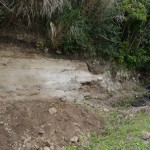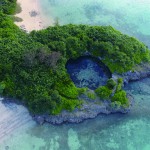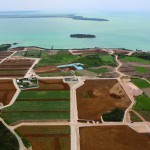【National Designation:Place of Scenic Beauty】Cape of Higashihennnazaki
Located at the eastern end of Miyakojima, the cape is a narrow protrusion of approximately 2km in total length, and 30m-150m in width. It is blessed with a unique natural environment, where indigenous coastal plant communities can be seen dispersed on the karst landform of Ryukyu limestone. The scenic beauty of the location is told in unique lore.
The surrounding cliffs of the cape are Ryukyu limestone formed into coastal cliffs. The flat area at about 20m above sea level is the lower terrace of the sea cliff, and the cape in general protrudes towards the sea. The terrace surface has caves and uvala and other concaves and depressions on the landform.
Scattered on the ground are lumps of Ryukyu limestone rocks, and in particular, found at around the tip of the cape, there is a large mass of rock around 6.8m in diameter, named Tsunami Ishi, and another huge mass of rock called Panari on the reef in the waters to the east of the cape. The waters in this area are said to be rough, and with the strong winds all year round, tall trees do not grow here, but instead, growths of plant communities particular to wind-swept areas in the subtropics can be found. In particular, the growth and distribution of Tennoume communities is of a significant scale that cannot be seen often elsewhere.
The breathtaking beauty of Higashihennna Cape is also highlighted by the traditional lore told on Miyakojima, a sad love story between an Aji chieftain and a beautiful girl. The tomb of the girl is at the shadows of the rocks where she is laid to rest. The cape is a beautiful location that highlights the distinguishing cultural characteristics of Miyakojima, and is also a valuable location to appreciate the scenic beauty and to achieve an academic understanding of the area.
Additional designation of the water area: February 7, 2011
≫View on a Google Map
 宮古島アプリの綾道(あやんつ)トップページ
宮古島アプリの綾道(あやんつ)トップページ 宮古島アプリの綾道(あやんつ)の内容
宮古島アプリの綾道(あやんつ)の内容 宮古島の3つのルート
宮古島の3つのルート 宮古島市長のあいさつ
宮古島市長のあいさつ 宮古島文化遺産紹介
宮古島文化遺産紹介








